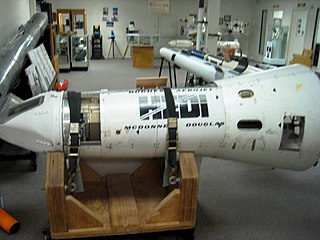 W
WThe Strategic Defense Initiative (SDI), nicknamed the "Star Wars program", was a proposed missile defense system intended to protect the United States from attack by ballistic strategic nuclear weapons. The concept was announced on March 23, 1983 by President Ronald Reagan, a vocal critic of the doctrine of mutually assured destruction (MAD), which he described as a "suicide pact". Reagan called upon American scientists and engineers to develop a system that would render nuclear weapons obsolete.
 W
WThe Ballistic Missile Defense Organization (BMDO) was an agency of the United States Department of Defense that began on 20 May 1974 with the responsibility for all U.S. ballistic missile defense efforts.
 W
WBrilliant Pebbles was a ballistic missile defense (BMD) system proposed by Lowell Wood and Edward Teller of the Lawrence Livermore National Laboratory (LLNL) in 1987, near the end of Cold War. The system would consist of thousands of small missiles, not unlike conventional heat seeking missiles, which would be placed in orbits so that hundreds would be above the Soviet Union at all times. If the Soviets launched its ICBM fleet, the pebbles would detect their rocket motors using infrared seekers and collide with them. Because the pebble strikes the ICBM before the latter could release its warheads, each pebble could destroy several warheads with one shot.
 W
WProject Casaba-Howitzer was a 1960s-era study into the use of nuclear weapons as the drivers for intense beams of plasma for use in space warfare. The basic concept grew out of work on the Project Orion spaceship concept, which studied nuclear shaped charges.
 W
WThe Exoatmospheric Reentry-vehicle Interceptor Subsystem, or ERIS, program, was a component of the United States' Strategic Defense Initiative during the Cold War. The ERIS system was named after Eris, Greek goddess of strife. ERIS was a kinetic kill system, launched from a ground-based system, and impacting directly to destroy an incoming Intercontinental ballistic missile (ICBM) before the targeted ICBM re-entered the Earth's atmosphere.
 W
WHigh Endoatmospheric Defense Interceptor (HEDI) was the atmospheric missile defense layer developed for the Strategic Defense Initiative, along with Exoatmospheric Reentry-vehicle Interceptor Subsystem. It consisted of a two-stage launch vehicle (booster) and an infrared homing kill vehicle with a conventional warhead. Hughes Aircraft and Aerojet were contractors, and McDonnell Douglas was the system integrator.
 W
WProject Excalibur was a Lawrence Livermore National Laboratory (LLNL) Cold War–era research program to develop an X-ray laser system as a ballistic missile defense (BMD) for the United States. The concept involved packing large numbers of expendable X-ray lasers around a nuclear device, which would orbit in space. During an attack, the device would be detonated, with the X-rays released focused by each laser to destroy multiple incoming target missiles. Because the system would be deployed above the Earth's atmosphere, the X-rays could reach missiles thousands of kilometers away, providing protection over a wide area.
 W
WSDI - Strategic Defense Initiative, or simply titled SDI and sometimes known as Global Defense, is a 1987 horizontally scrolling shooter produced and released internationally in arcades by Sega. It was later ported to home computers and game consoles, some by other companies. Players control a satellite and must destroy enemies by moving a crosshair over them and firing the satellite's weapons.